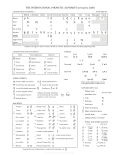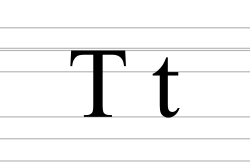⟨ ⟩, see IPA § Brackets and transcription delimiters. In phonetics, a plosive, also known as an occlusive or simply a stop, is a pulmonic consonant in...
18 KB (2,116 words) - 09:29, 28 May 2025
The voiceless velar plosive or stop is a type of consonantal sound used in almost all spoken languages. The symbol in the International Phonetic Alphabet...
22 KB (912 words) - 05:55, 26 May 2025
voiced velar plosive or stop is a type of consonantal sound used in many spoken languages. Some languages have the voiced pre-velar plosive, which is articulated...
25 KB (1,362 words) - 06:48, 25 May 2025
The voiceless alveolar, dental and postalveolar plosives (or stops) are types of consonantal sounds used in almost all spoken languages. The symbol in...
38 KB (1,732 words) - 23:21, 27 May 2025
The voiced palatal plosive or stop is a type of consonantal sound in some spoken languages. The symbol in the International Phonetic Alphabet that represents...
18 KB (1,079 words) - 22:56, 27 May 2025
The voiceless palatal plosive or stop is a type of consonantal sound used in some vocal languages. The symbol in the International Phonetic Alphabet that...
26 KB (1,239 words) - 23:01, 27 May 2025
The voiceless bilabial plosive or stop is a type of consonantal sound used in most spoken languages. The symbol in the International Phonetic Alphabet...
25 KB (964 words) - 03:43, 28 April 2025
The voiced uvular plosive or stop is a type of consonantal sound, used in some spoken languages. The symbol in the International Phonetic Alphabet that...
10 KB (670 words) - 21:23, 4 March 2025
voiceless uvular plosive or stop is a type of consonantal sound, used in some spoken languages. It is pronounced like a voiceless velar plosive [k], except...
21 KB (1,034 words) - 18:32, 4 May 2025
Glottal stop (redirect from Voiceless glottal plosive)
The glottal stop or glottal plosive is a type of consonantal sound used in many spoken languages, produced by obstructing airflow in the vocal tract or...
43 KB (2,577 words) - 14:43, 24 May 2025
The voiced linguolabial plosive or stop is a type of consonantal sound used in some spoken languages. The symbol in the International Phonetic Alphabet...
2 KB (182 words) - 00:31, 22 April 2025
The voiced alveolar, dental and postalveolar plosives (or stops) are types of consonantal sounds used in many spoken languages. The symbol in the International...
30 KB (1,222 words) - 13:46, 10 April 2025
The epiglottal or pharyngeal plosive (or stop) is a type of consonantal sound, used in some spoken languages. The symbol in the International Phonetic...
4 KB (332 words) - 18:35, 4 May 2025
Velar consonant (redirect from Voiced velodorsal plosive)
best, is reconstructed for Proto-Indo-European. Apart from the voiceless plosive [k], no other velar consonant is particularly common, even the [w] and...
13 KB (1,089 words) - 16:32, 4 May 2025
The voiceless labiodental plosive or stop is a consonant sound produced like a [p], but with the lower lip contacting the upper teeth, as in [f]. This...
3 KB (261 words) - 03:59, 30 May 2024
List of consonants (section Plosive (stop) consonants)
voiceless velar plosive [k] voiced velar plosive [ɡ] voiceless uvular plosive [q] voiced uvular plosive [ɢ] epiglottal plosive [ʡ] glottal plosive [ʔ] Sibilant...
27 KB (2,207 words) - 01:57, 11 May 2025
bidental fricative [h̪͆] Voiceless upper-pharyngeal plosive [ʡ̟] Voiced upper-pharyngeal plosive [ʡ̟̬] Bilabial percussive [ʬ] Bidental percussive [ʭ]...
13 KB (170 words) - 10:31, 1 June 2025
The voiced labiodental plosive or stop is a consonant sound produced like a [b], but with the lower lip contacting the upper teeth, as in [v]. This can...
3 KB (280 words) - 22:30, 6 April 2025
English, it is most commonly used to represent the voiceless alveolar plosive, a sound it also denotes in the International Phonetic Alphabet. It is...
16 KB (1,285 words) - 06:24, 29 May 2025
bilabial plosives are as follows: voiced labio-velar approximant, voiceless aspirated bilabial plosive, voiceless unaspirated bilabial plosive, voiceless...
29 KB (3,103 words) - 21:29, 1 June 2025
letter of the Cyrillic script. It commonly represents the voiced bilabial plosive /b/, like the English pronunciation of ⟨b⟩ in "ball". It should not be...
5 KB (402 words) - 10:08, 22 April 2025
International Phonetic Alphabet, opentail ⟨⟩ has always represented a voiced velar plosive, while looptail ⟨⟩ represented a voiced velar fricative from 1895 to 1900...
32 KB (2,763 words) - 04:55, 22 May 2025
of obstruents always agree in voicing, and clusters of sibilants and of plosives with the same point of articulation are prohibited. Several consonants...
229 KB (23,429 words) - 18:16, 2 June 2025
The voiced bilabial plosive or stop is a type of consonantal sound used in many spoken languages. The symbol in the International Phonetic Alphabet that...
19 KB (758 words) - 18:31, 4 May 2025
The voiceless labial–retroflex plosive is a type of consonantal sound used in the Yele language. It is a [ʈ] and [p] pronounced simultaneously. The symbol...
2 KB (238 words) - 05:01, 20 August 2024
The voiceless retroflex plosive or stop is a type of consonantal sound, used in some spoken languages. This consonant is found as a phoneme mostly (though...
12 KB (624 words) - 18:35, 4 May 2025
§ Brackets and transcription delimiters. The voiceless upper-pharyngeal plosive or stop is a rare consonant. Pharyngeal consonants are typically pronounced...
3 KB (547 words) - 20:22, 10 January 2025
IPA § Brackets and transcription delimiters. The voiced upper-pharyngeal plosive or stop is a rare consonant. Pharyngeal consonants are typically pronounced...
3 KB (526 words) - 18:35, 14 April 2025
The voiced labial–retroflex plosive is a type of consonantal sound used in the Yele language. It is a [ɖ] and [b] pronounced simultaneously. The symbol...
2 KB (236 words) - 04:59, 20 August 2024
Labialization (redirect from Labialized voiceless velar plosive)
[ʔʷ] Adyghe, Kabardian, Lao, Tlingit labzd prenasalized voiced bilabial plosive [ᵐbʷ] Tamambo Labial–velar protruded voiceless labio–velar stop [k͡pʷ]...
23 KB (1,088 words) - 08:45, 29 April 2025



















